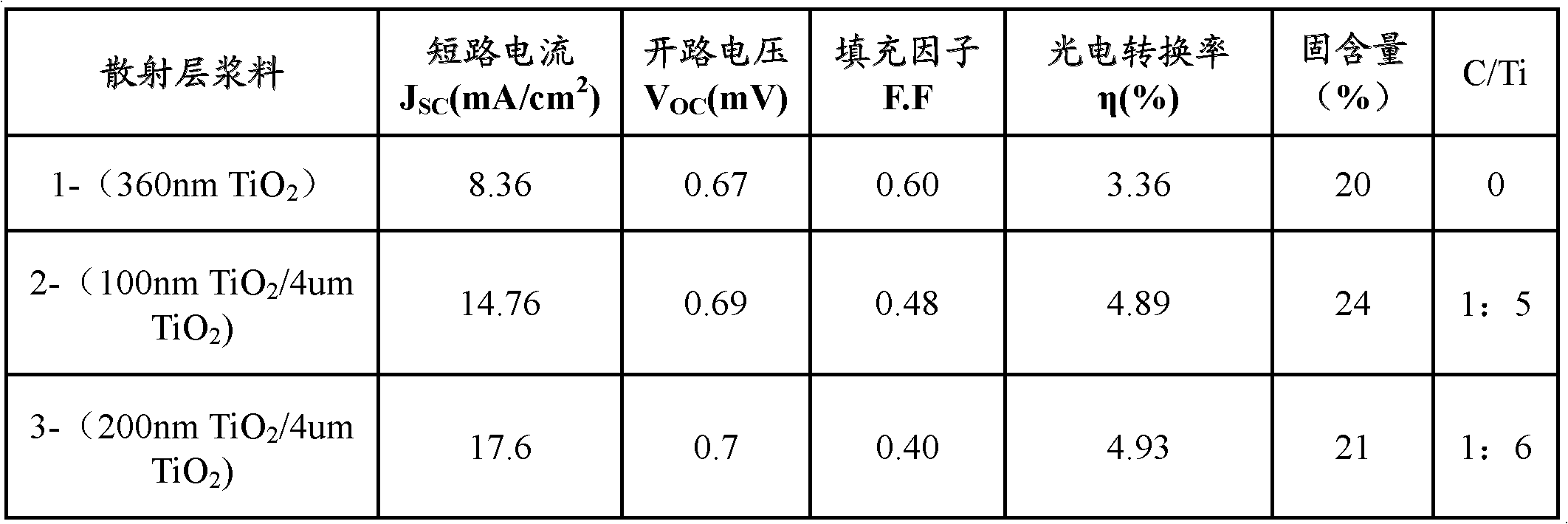Method for preparing DSC light anode scattering layer slurry
A technology of anode paste and scattering layer, applied in photosensitive devices, conductive materials dispersed in non-conductive inorganic materials, photovoltaic power generation, etc. Performance, good light scattering effect
- Summary
- Abstract
- Description
- Claims
- Application Information
AI Technical Summary
Problems solved by technology
Method used
Image
Examples
Embodiment 1
[0011] (1) Preparation of organic carrier
[0012] According to the mass ratio of 1:5, 10 g of ethyl cellulose was added to 50 g of terpineol, and then stirred in a water bath at 80° C. for 2 hours to prepare an organic vehicle with a viscosity of 6.1 cp and set aside;
[0013] (2) TiO with a solid content of 24% 2 Preparation of Scattering Layer Slurry
[0014] According to the mass ratio of 1:5, take anatase TiO with a particle size of 4um 2 TiO with a particle size of 100nm 2 After mixing, put it into an agate mortar, then add the organic vehicle with a viscosity of 6.1 cp obtained in step 1, and grind it thoroughly for 1 hour to form TiO 2 Scattering layer slurry, wherein the solid content of the organic vehicle is 24%;
[0015] (3) Preparation of anode slurry
[0016] On the cleaned conductive glass substrate, the light absorbing layer TiO was screen-printed with 250 mesh stainless steel 2 slurry, forming a layer of TiO 2 light-absorbing layer film, followed by TiO...
Embodiment 2
[0018] (1) Preparation of organic carrier
[0019] According to the mass ratio of 1:5, 20 g of ethyl cellulose was added to 100 g of terpineol, and then stirred in a water bath at 80° C. for 2 h to form an organic vehicle with a viscosity of 6.1 cp, which was set aside.
[0020] (2) TiO with a solid content of 18% 2 Preparation of Scattering Layer Slurry
[0021] According to the mass ratio of 1:9, take 1.8g of anatase TiO with a particle size of 4um 2 with 16.2g of TiO with a particle size of 100nm 2 After mixing, put it into an agate mortar, then add the organic vehicle with a viscosity of 6.1 cp formed in step 1, and grind it thoroughly for 1 hour to form TiO 2 Scattering layer slurry, wherein the solid content of the organic vehicle is 18%;
[0022] (3) Preparation of anode slurry
[0023] On the cleaned conductive glass substrate, the light absorbing layer TiO was screen-printed with 250 mesh stainless steel 2 slurry, forming a layer of TiO 2 light absorbing layer ...
Embodiment 3
[0025] (1) Preparation of organic carrier
[0026] According to the mass ratio of 1:7, 10 g of ethyl cellulose was added to 70 g of terpineol, and then stirred in a water bath at 80° C. for 2 hours to form an organic carrier with a viscosity of 6.0 cp, which was set aside;
[0027] (2) TiO with a solid content of 21% 2 Preparation of Scattering Layer Slurry
[0028] According to the mass ratio of 1:6, take 3.0g of anatase TiO with a particle size of 4um 2 with 18g of TiO with a particle size of 200nm 2 After mixing, put it into an agate mortar, then add the organic vehicle with a viscosity of 6.0 cp obtained in step 1, and grind it thoroughly for 1 hour to form TiO 2 Scattering layer slurry, wherein the solid content of the organic vehicle is 21%.
[0029] (3) Preparation of anode slurry
[0030] On the cleaned conductive glass substrate, the light absorbing layer TiO was screen-printed with 250 mesh stainless steel 2 slurry, forming a layer of TiO 2 Light-absorbing lay...
PUM
| Property | Measurement | Unit |
|---|---|---|
| particle diameter | aaaaa | aaaaa |
| particle diameter | aaaaa | aaaaa |
| particle diameter | aaaaa | aaaaa |
Abstract
Description
Claims
Application Information
 Login to View More
Login to View More - R&D Engineer
- R&D Manager
- IP Professional
- Industry Leading Data Capabilities
- Powerful AI technology
- Patent DNA Extraction
Browse by: Latest US Patents, China's latest patents, Technical Efficacy Thesaurus, Application Domain, Technology Topic, Popular Technical Reports.
© 2024 PatSnap. All rights reserved.Legal|Privacy policy|Modern Slavery Act Transparency Statement|Sitemap|About US| Contact US: help@patsnap.com








